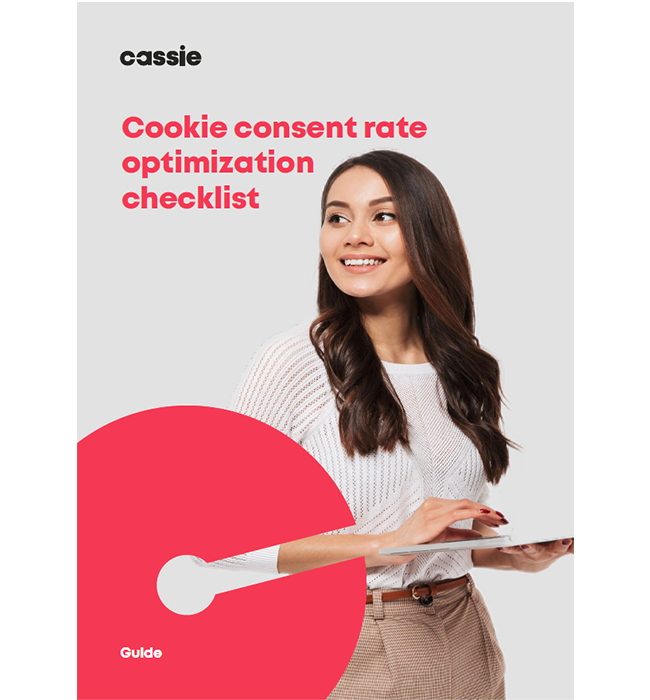Balancing compliance and UX: How to improve cookie consent rates
Posted: March 7, 2024
There are constant advancements in technology and different ways in which organizations can gather data to build a core understanding of their customers.
Whilst this obviously has its advantages, these advancements do not come without any risks. Finding a balance between data compliance and the user experience is vital because consumers are gradually becoming more concerned about their data privacy and their willingness to share.
Improving cookie consent rates (sometimes referred to as consent rate optimization) is vital for websites. This allows organizations to demonstrate total compliance with relevant data privacy regulations whilst enhancing the user experience by implementing personalization and protecting the privacy of consumers.
If a user doesn’t accept cookies, marketers can lose access to third party data related to attribution, engagement, and behavior. Because of this, it’s crucial that we find the appropriate balance between compliance and user experience to improve cookie consent rates.
Understanding cookie consent
Cookie consent plays a significant role in the safeguarding of personal data by giving users control over the collection and processing of their personal information.
Cookies, commonly referred to as internet cookies, function as text files containing discrete data fragments such as user credentials (e.g., IP address, username or passwords). Their primary purpose is to distinguish and identify your computer within a networked environment. Specific cookies serve the crucial role of pinpointing individual users and optimizing their web browsing experience.
Upon establishing a connection, the server generates data within a cookie, assigning it a distinctive ID tied to your computer. Subsequently, when the cookie is exchanged between your computer and the network server, the server deciphers the ID, allowing it to precisely cater to your informational needs. This intricate process facilitates a more personalized and efficient interaction between users and networked systems.
Depending on where your users are visiting your website from, you may be required to inform users about the types of cookies used, as well as their purposes and how they impact user privacy, usually via a cookie banner.
For some data protection laws like GDPR, users must be given the option to opt in to consent to their data being collected using a cookie banner. Most US state privacy laws like CCPA don’t have to request consent to gather data from users via a cookie, but they must provide users with the option to opt-out of their data being collected. When dealing with consent management, it’s important to understand the different cookie consent rules across regions.
Not only is it a legal requirement for organizations to inform customers on how their data is being collected, used, and shared, it also supports in building stronger relationships with your customers. By respecting your customers’ consent preferences you are reassuring users whilst mitigating concerns and building customer trust.
What percentage of people accept cookies?
The average cookie consent rate varies wildly across different regions and industries. A recent study found that 40% of Americans blindly accept cookies, with the majority not knowing what they mean.
However, 18% unanimously reject cookie consent, whilst 44% take the time to research how their cookies will be used and then make an informed decision.
So a large percentage of people are hesitant when it comes to cookie policies. Our research found that people would be more willing to opt in if they were given full transparency over how their data would be used.
Challenges in balancing compliance and UX
Trying to find a balance between data privacy law compliance and user experience (UX) can pose several challenges to organizations.
Consent fatigue
During the customer journey, users are bombarded with consent requests across various websites and channels. In turn, this leads to consent fatigue and can frustrate the user to the point where they prematurely leave their website session. This is the impact cookie consent banners can have on cookie acceptance statistics.
Consent fatigue makes it challenging for organizations to obtain meaningful consent from users who may be inclined to ignore consent prompts without fully understanding their implications. Whether the standard cookie consent language is confusing or the consent banner design is intrusive, various factors can increase consent fatigue.
Cassie’s Cross-Domain Consent module enables organizations to reduce consent fatigue for consumers. When a visitor accepts a cookie on one website domain and proceeds to visit another brand website where the module is enabled, users will not see another cookie banner. Any future changes to cookie consent preferences will automatically sync between domains whilst ensuring cookie compliance is met.
Complexity of data privacy laws
Data protection regulations such as GDPR and CCPA are complex and often subject to interpretation. The European Union Court of Justice (CJEU) has even declared that in order for unintentional GDPR violations to result in enforcement, some degree of negligence or malice is required.
To be able to ensure complete compliance of these data privacy regulations, it can require a deep understanding of data privacy which can be difficult for organizations to manage without jeopardizing business aims and objectives.
Many websites are unknowingly non-compliant. Just recently, the ICO flagged privacy concerns with some of the most popular websites in the EU, informing them that they are not following the regulations when it comes to cookie consent rules.
Opt-ins & opt-outs
Designing cookie consent banners that allow users to easily opt-in/opt-out presents a challenge to data controllers. This is because, depending on the privacy law, failure to provide the correct banner can raise concerns with users’ privacy and security, and potentially result in fines and other consequences like damage to reputation.
For example, GDPR requires data controllers to request users to consent to sharing data which has a positive impact on data security and legislation compliance. Despite this, it can have the reverse effect on UX because it may lead to lower engagement rates. US privacy laws do not have to present cookie consent banners to gather data from users which results in larger quantities of data but also raises concerns over a lack of transparency. Some states have implemented ‘do not track’ legislation, whereby businesses need to provide users with the ability to opt-out.
5 strategies for improving cookie consent rates
1. Transparent communication
Transparent communication plays a crucial role in improving cookie consent rates. This is a very effective strategy to implement into your website because it supports in building customer trust and empowers your customers to make informed decisions regarding their personal information.
Being transparent with the user means providing them with clear and understandable information about how their data is being managed. This can then help them to make informed decisions which has been shown to make it more likely for them to accept internet cookies on your website.
2. User-friendly design
Implementing a user-friendly design reduces frustration and confusion from users as it simplifies the cookie consent process. Optimizing cookie consent banners and preference lists by simplifying questions and eliminating unnecessary jargon means that users will quickly be able to make decisions about their data without getting overwhelmed by questions.
3. Branding
Everyone is aware of the importance of consistent branding across your website. The importance of this consistency also transfers to the cookie consent process as it helps in developing familiarity. Familiarity then provides reassurance over the legitimacy of any consent requests.
4. Granularity
We would recommend considering granularity in control options when developing a user-friendly cookie consent banner design. Providing options for users to consent to specific types of cookies can help to reduce consent fatigue as well as provide some insight into user behavior.
5. Personalization and customization
Personalization allows websites to customize the cookie consent experience based on user preferences and previous interactions. By analyzing user data such as browsing history, location, and device type, websites can present tailored consent prompts that resonate with users’ interests and needs, increasing the likelihood of consent.

Cookie Consent Checklist: 20+ Points to Consider
Do you actively monitor the performance of your cookie banners or regularly make changes to enhance engagement? Cookie banner optimization is essential to increase user engagement and build trust. This free guide covers 20+ cookie banner optimization points to consider that meet regulatory guidelines and improve higher opt-in rates, so that your business can achieve compliance without compromise.

